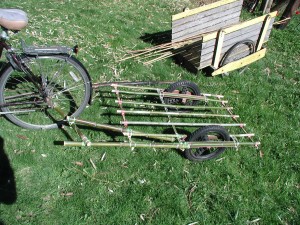 Do you want to build your own bamboo bicycle trailer?
Do you want to build your own bamboo bicycle trailer?
We do! As the first of Transition Amherst’s monthly skill workshops, twelve of us got together on March 24th at the Neighborhood Bicycle Resource Center, for the first of a two-part workshop to build bicycle trailers out of bamboo mostly. We harvested a lot of culms (as they call the bamboo stalks), learned how to fasten them to each other with strings, and made wheel mounts for the trailers.
As homework, everyone was to acquire the two wheels for the trailers, and build the flatbed body of the trailer, using the rope technique we learned (or I hear someone expect to use an even better version).
On April 21th and May 12 (both Saturday, at 2:30pm) several participants came with their partial trailer (that still qualified as finished homework) to build the bicycle hookups, the front arm of the trailer, that hooks onto the bicycle hookup, and to test the trailers.
So as a summary, here are the steps involved, that we went through as part of the workshop (needed hardware is 2 wheels, angle iron, sheet metal, male spherical connection ball joint, non-twisting rope, metal saw, some welding skill, drill and bamboo of course):
- Design the size and weight bearing requirements of your trailer. The wider the trailer is the wider the load can be, but the stronger and more numerous the cross pieces need to be as well, and the harder to navigate in traffic, and avoid running into obstacles, especially curbs and posts and trees, with the outer edge of the trailer.
- Get your wheels, and make the 4 wheel hookup pieces. I usually use angle iron, cut in half way and bend out the middle piece cut a slot for the wheel axle to fit. and mount the pieces on each side of the wheel.
- Harvest the culms: using them green or aged makes little difference, as bamboo changes its shape and size hardly during the drying process. 3-5 year old culms are the best, but up here they rarely get that old, as during a hard winter most of the above-ground part of the bamboo dies back. However 1 year old culms may be used as well – they may be just a bit more prone to the effects of the weather, and just a bit weaker, but still pretty much as strong as a steel pipe of comparable size and same weight.
- Cut the culms to size and lay the trailer pieces out. Leave the two pieces on the left side of the bike longer, for the hookup arm. Those pieces should be the strongest, especially their front.
- Fasten the laid-out pieces to each other with the technique we learned. This is the longest part of the process. The string has to be very tight, as this is what holds the whole trailer together. So any technique that further ties the rope as it is mounted, will work better. I usually just do one hour of this work in one segment, as my hands and fingers get tired from pulling. I use some glue to keep the rope in place once the knot is made. when fastening the outside pieces where wheel will go, fit the wheel with the wheel hookup angle iron into the frame, so you make sure the position of the bamboo pieces is correct. Alternatively you can also use screws to fasten the pieces. I prefer rope, because the tie is lighter and better looking, structurally it leaves the culm stronger and more weather resistant and is lower tech, as it doesn’t need a drill (pre-drilling is a must with bamboo, as it doesn’t “give”) or metal screws that may rust.
- Using 1/8 or 3/16 sheet metal, and the spherical joint, put the bicycle hookup together. Or see me for help. This is the only part that absolutely needs welding. There are different methods to hook the trailer up, but I am yet to find a low-tech version, other than using cut inner tubes for a flexible joint.
- Make the bamboo hookup arm. Sometimes I use a steel pipe, as I don’t have thick enough bamboo for that. the end need to be drilled and a slot need to be cut for the radial ball joint, big enough so the joint can move around, as move it will.
- Fasten the piece to the pieces of the trailer that you left longer.
- Use stronger ropes or another bamboo (or install a plywood piece on top of the trailer) to stop/minimize torsional bending. The bike will pull the trailer on one side. So without one of these actions the trailer will be out of alignment in no time.
- Hook up, and weight-test your trailer. The more weight you want to carry the stronger (and heavier) your frame needs to be. Over 100 pounds I would use that plywood piece.
There are some other related happenings and plans:
I got interviewed by Cris from networx.com. Here is the article.
A new group of people are interested in building more trailers. They are organizing a workshop.
If they don’t get around setting something up sooner, I plan to repeat the workshop next spring.
A few pictures from March 24 as inspiration. They attempt to show the different parts of the process of making the trailer, trailers, that we made, and the weight-testing of one of the trailers:

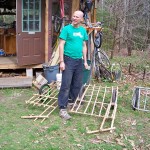
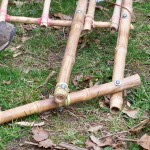
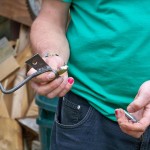
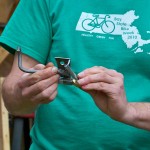
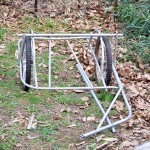
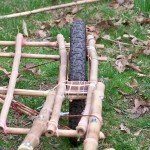
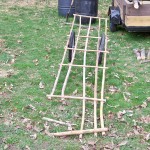
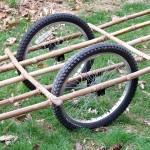
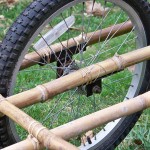
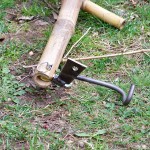
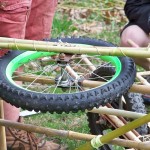
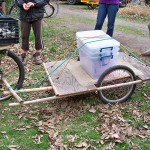
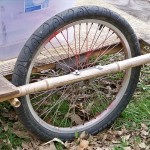
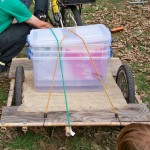
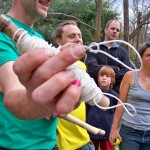
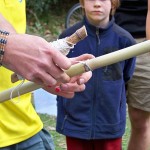
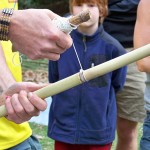
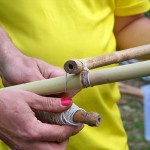
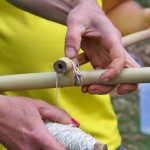
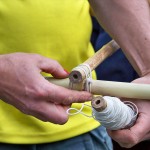
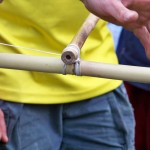
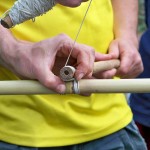
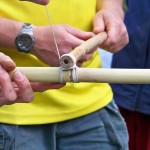
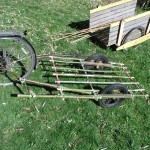
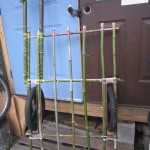
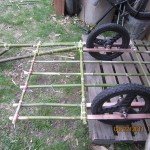
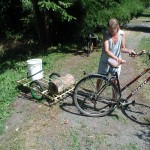

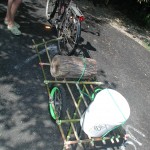
One Response to Building Bicycle Trailers